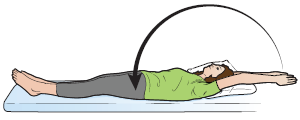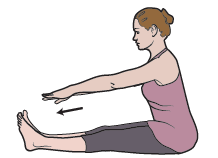This information will explain how you can manage cancer-related fatigue (feeling more tired or weak than usual) by exercising.
About Cancer-Related Fatigue
Fatigue is the most common side effect of cancer and cancer treatment. People describe cancer-related fatigue as:
- Feeling tired even after resting or sleeping
- Feeling weak
- Not wanting to do things
- Not being able to focus
- Feeling slowed down
- Tiredness that affects your work, social life, or daily routine
Cancer-related fatigue is different from fatigue experienced by people without cancer. It doesn’t get better with rest. Some people with cancer-related fatigue may feel too tired to eat or walk to the bathroom. Cancer-related fatigue can last from months to years. It can also begin suddenly and get worse over time.
There are many things you can do to help manage your fatigue. The first step is talking with your healthcare provider about what you’re feeling. It’s helpful to be specific when you describe your fatigue to them. For example, saying “I was so tired that I couldn’t work for 3 days” is more helpful than saying “I was really tired.”
For more information about cancer-related fatigue and how to manage it, read our resources Managing Cancer-Related Fatigue and Managing Cancer-Related Fatigue for Survivors. You may also find it helpful to watch this video.
Cancer-Related Fatigue and Exercise
For many people with cancer-related fatigue, the thought of exercising can feel overwhelming. You may feel more comfortable resting. Resting too much can lower your energy even more and make you feel more fatigued.
Light exercise, like walking or riding a bike, can help with your fatigue by:
- Increasing your energy levels.
- Increasing your strength.
- Reducing pain and nausea.
- Improving your ability to do everyday tasks.
- Improving your sleep.
- Reducing stress and anxiety.
Finding a balance between rest and exercise
Doing light exercises can help you manage fatigue, but overworking your body can make you feel more fatigued. Listen to your body and rest when you need to. It’s important to come up with a routine or exercise plan that works for you.
Working with a physical therapist or occupational therapist
Physical therapists (PTs) and occupational therapists (OTs) are healthcare professionals who can help you manage your fatigue with exercise.
- PTs help improve your ability to move by helping you regain strength and balance. They can also help you come up with an exercise plan that works for you.
- OTs help improve the skills you need to do important everyday activities, such as getting dressed, taking a shower, or cooking a meal. They can help you come up with a plan to do these activities without getting too tired. They can also teach you how you can save your energy. OTs can show you how to use special equipment, such as tools to help you get dressed. They can also teach you other ways you can improve your fatigue, such as through meditation.
PTs and OTs can help you stay motivated and set goals. They can also help you keep track of your energy level and make changes to your exercise plan as needed. If you would like more information about how a PT or OT can help you manage your fatigue, ask your healthcare provider for a referral.
Tips for Exercising When You Feel Fatigued
Exercising when you feel fatigued can be hard. Here are some ways to make it easier for you to get started.
- Pick an activity that you like. Try different things, such as walking, yoga, or dancing.
- Find a time to exercise that works best for you. Pain and fatigue can change from day to day or even hour to hour. Track your energy level to see when is the best time for you to exercise.
-
Set both short-term and long-term exercise goals.
- For example, your short-term goal could be to walk around your neighborhood for 15 minutes on 3 different days of the week.
- Your long-term goal could be to slowly add more time and days until you’re walking 30 minutes a day, 5 days a week.
- Start slowly. Break up exercises into small amounts of time, such as 3 times a day for 15 minutes, instead of 1 longer block of time. Remember to pace yourself.
- Take breaks. Taking rest breaks will help you stay active for longer.
- Track your time and progress on a chart. You can use the chart at the end of this resource or you may want to use an app on your phone.
- Exercise with friends and family. Having a support network can help you work towards your goals.
- Don’t force yourself to follow a strict routine. Stop when you need to.
- Stay hydrated. It’s important to drink water before, during, and after exercising.
Types of Exercises
Here are some examples of the types of exercises you can do. You can also work with a PT or OT to come up with an exercise plan that works for you. Talk with your healthcare provider before you start any new exercises.
Aerobic exercises
Aerobic exercises increase your heart rate and energy level. Examples of aerobic exercises include:
- Walking outside or on a treadmill
- Light jogging
- Swimming
- Riding a bike
You can try any of these exercises and see how they make you feel. Depending on your fatigue and comfort level, you may want to start with a 10 minute walk and walk for a longer amount of time each day. You should also take rest breaks whenever you feel you need to.
Exercises to help you feel stronger
These exercises help you build muscle and feel less fatigued. Here are some examples of strengthening exercises you can do. Your doctor, PT, or OT can give you more recommendations.
Ankle circles
- Lie on your back or sit up.
- Rotate your right ankle clockwise (to the right) 10 times (see Figure 1).
- Rotate your right ankle counter-clockwise (to the left) 10 times.
-
Repeat the exercise with your left ankle.

Figure 1. Ankle circles
Ankle pumps
- Lie on your back or sit in a chair with your legs stretched out.
- Point your toes up toward your nose and then down to the floor (see Figure 2). You can do this with both feet at the same time.
-
Repeat 10 times.

Figure 2. Ankle pumps
Marching in place
- Sit in a chair with armrests and place your feet flat on the floor.
- Slowly raise 1 knee without tilting or leaning backward (see Figure 3). You can prevent your upper body from tilting backward by holding the armrests.
- Lower your leg and return your foot to the floor.
- Repeat 5 times.
-
Repeat with your other leg.

Figure 3. Marching in place
Sitting kicks
- Sit in a chair. Keep your feet flat on the floor.
- Kick 1 foot up from the floor until your leg is straight out in front of you (see Figure 4).
- Hold the position and count out loud to 5.
- Lower your foot to the floor.
- Repeat 10 times.
-
Repeat with your other leg.

Figure 4. Sitting kicks
Arm raises
- Sit or stand comfortably with your back straight, shoulders back, and your head facing forward.
- Raise your arms out to the side, up to the level of your shoulders. Keep your elbows straight (see Figure 5).
- Hold for 5 seconds.
- Lower your arms to your sides.
-
Repeat this 10 times.

Figure 5. Arm raises
Stretching exercises
Gentle stretching can help improve your flexibility and reduce stress. This can make you feel less fatigued. Here are some examples of stretching exercises you can do. Your doctor, PT, or OT can give you more recommendations.
Overhead stretch for arms
- Lie on your back with your head and shoulders supported on pillows.
- Start with both arms close to your sides. Raise both of your arms forward and up over your head (see Figure 6).
- Keep your arms on the pillow so that your arms are near your ears (see Figure 7).
- Hold the position and count out loud to 5.
- Slowly bring your arms up in the air and return them to the starting position.
-
Repeat 10 times.

Figure 6. Arms at your side 
Figure 7. Arms over your head
Leg stretch
- Sit with your legs straight out in front of you.
- Reach to touch your toes, keeping your knees and back straight (see Figure 8).
- Hold this position for 30 to 45 seconds.
-
Slowly release.

Figure 8. Leg stretch
Side neck stretch
- Sit in a chair.
- Keeping your head facing forward, slowly bring your left ear to your left shoulder.
- Place your left hand on the right side of your head to gently press your ear closer to your shoulder until you feel a comfortable stretch along the side of your neck (see Figure 9).
- Hold this position for 30 to 45 seconds.
- Slowly release.
-
Repeat on the other side.

Figure 9. Side neck stretch
Deep breathing exercise
Deep breathing is an exercise that can help you relax and reduce your fatigue.
- Sit comfortably in a chair or lie in your bed. If you’re lying in bed, raise your head on several pillows. You may also want to place a pillow under your knees.
- Place 1 hand on your stomach, just above your belly button.
- Breathe out completely through your mouth.
- If you can, close your eyes and breathe in slowly and deeply through your nose (see Figure 10). Feel your stomach push up on your hand. Imagine that air is filling your whole body from the bottom up.
- Pause for a couple of seconds. Then, breathe out slowly through your mouth or nose (see Figure 11). Try to breathe out completely and imagine the air leaving your lungs, mouth, or nose.
- As you breathe out, let your body relax and go limp, like a rag doll.
-
Repeat this exercise 5 to 10 times.

Figure 10. Breathing in through your nose 
Figure 11. Breathing out through your mouth
Resources
American Cancer Society (ACS)
www.cancer.org/treatment/treatments-and-side-effects/physical-side-effects/fatigue.html
800-ACS-2345 (800-227-2345)
ACS provides information and resources about managing cancer-related fatigue for people with cancer, their families, and caregivers.
